One of our favorite festive plants is the poinsettia; whether you love the bright red festive species or the white, it’s not Christmas without one. However, that doesn’t mean our pets respect them! Chewing on houseplants is a common problem, so here are the 12 most effective ways to keep your dogs and cats out of your poinsettias (and other houseplants).
Are Poinsettias Toxic to Dogs and Cats?
Poinsettias are mildly toxic to cats and dogs. Their sticky white latex sap contains chemicals that cause adverse reactions.
According to the ASPCA, the symptoms of poinsettia poisoning in cats and dogs include drooling, vomiting, diarrhea, and skin irritation. It’s rarely serious or fatal, but it’s best to prevent Tigger or Rover from chewing or playing with a poinsettia.
That’s all very well to say in theory, but how exactly can one do it? Here are 12 ways to stop your cat and dog from going near poinsettias or unsuitable plants.
1. Raise Up High

If your cat or dog won’t leave it alone, put your poinsettia on a high shelf like these pothos plants.
©Amir Hafidz/Shutterstock.com
Placing a poinsettia somewhere your cat or dog can’t reach is the best way to avoid poisoning. Floor-based plants are a big no-no, and even table poinsettias are within reach if your cat (or dog!) is the athletic type.
A high shelf, hanging basket, or decorated birdcage well out of reach is the best way to keep pets out of your poinsettias. High-up poinsettias also display a different view of the leaves’ undersides. It’s a beautiful display and a bit out of the ordinary, especially if it’s near a spotlight.
2. Glass Covers
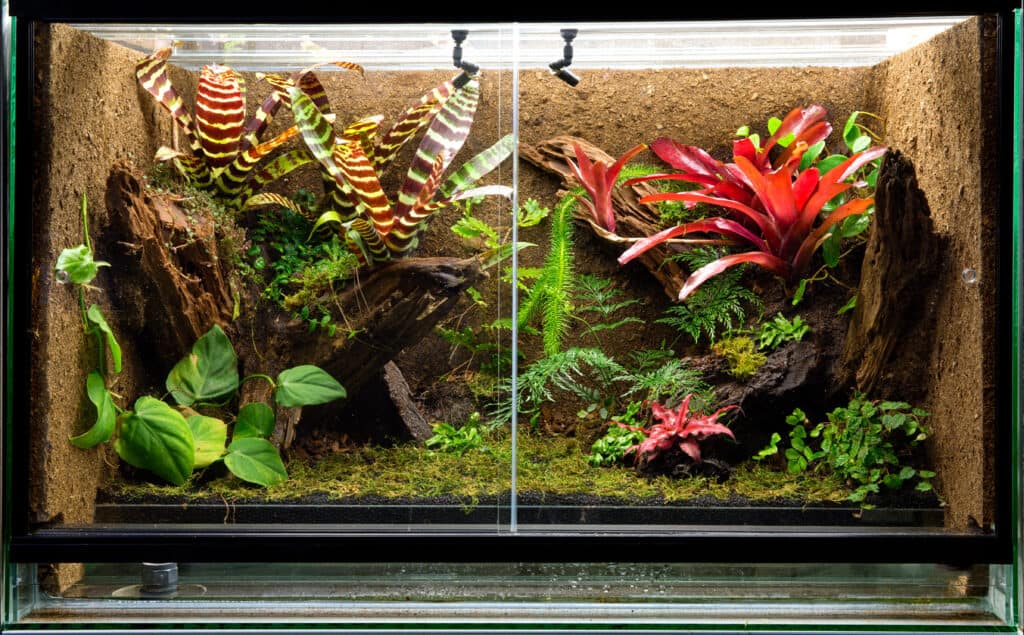
Use an old aquarium or terrarium to protect your festive poinsettia from cat and dog attention.
©Dirk Ercken/Shutterstock.com
Here’s an unusual suggestion! Some folks place their toxic pet plants in glass containers, aquariums, or terrariums. This allows plants plenty of light but protects them from your cat and dog’s unwanted attention.
A glass container works well for Christmas decorations, such as battery-powered lights that your house rabbit might want to chew on.
3. Don’t Put Them In Your Pet’s Usual Spot

Don’t put poinsettia plants in your dog or cat’s usual spot.
©Jay Ondreicka/Shutterstock.com
Does your cat sprawl out on the windowsill like “This is my windowsill,” or does your dog jump up by the front door when it’s time for a walk? Here’s a simple way to keep your dogs and cats out of your poinsettias.
Don’t put a poinsettia there! It attracts attention and asks for trouble. Choose a spot that your pets don’t take much notice of. Even if it’s not prime viewing, it’s better than a shattered container or a sick pet.
4. Put Citrus on the Foliage

Soak citrus peel in water overnight and spray it on poinsettia foliage to discourage pets.
©Africa Studio/Shutterstock.com
Most animals dislike the citrus scent; it’s the plant world’s way of discouraging chewers. Enable this natural world solution!
Soak lemon, orange, or lime peel in water and spray it on your poinsettia foliage. It won’t harm the plant. Soaked peel is strongest, but you could spray juice in water instead.
5. Cover the Soil

Place fabric or stones on poinsettia soil so pets can’t dig. It deters fungus gnats, too.
©pundapanda/Shutterstock.com
Often, the outdoorsy scent of soil attracts cat and dog noses to pot plants.
Cover your poinsettia’s soil with a piece of fabric or stones to discourage your pets from digging there. It is a great way to keep your dogs and cats out of your poinsettias, but it also helps prevent fungus gnats from breeding in the damp soil.
6. Put Citrus on the Soil
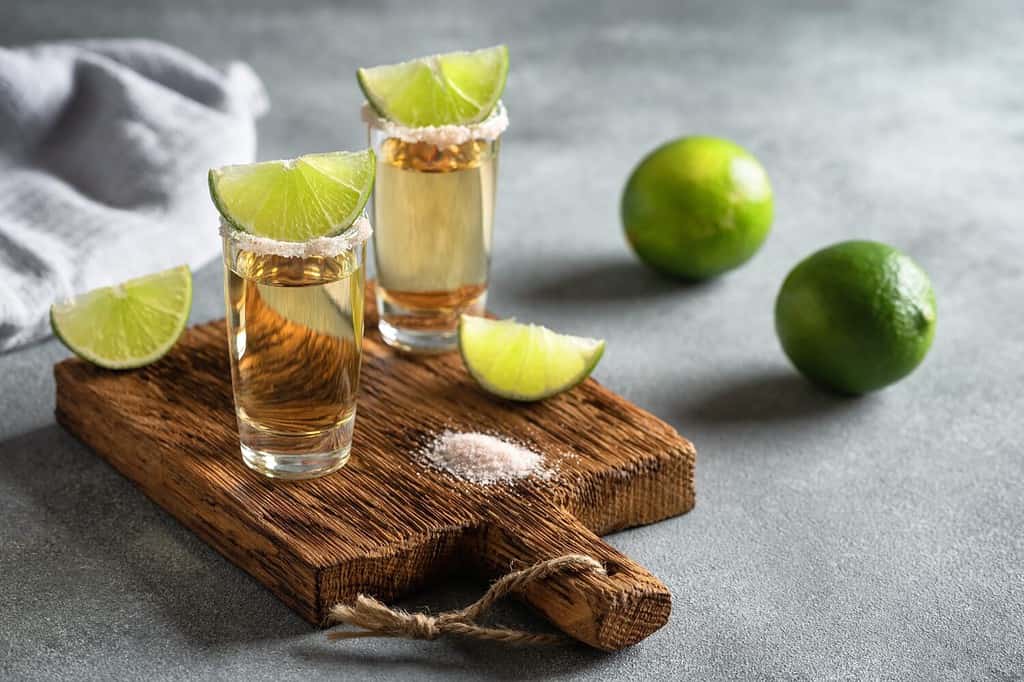
Squeeze citrus fruit juice onto poinsettia soil to put off cats and dogs.
©Yulia Gust/Shutterstock.com
Essential oil of the citrus variety is a great way to keep your dogs and cats out of your poinsettias. Add a few drops directly on the soil, or drip them on a tissue and add it to the soil.
If you don’t have essential oil handy, try dripping freshly squeezed lemon or orange. You’ll need to replenish it every few days. As a bonus, it’ll make your home smell fresh and clean.
7. Buy Pet Off Spray
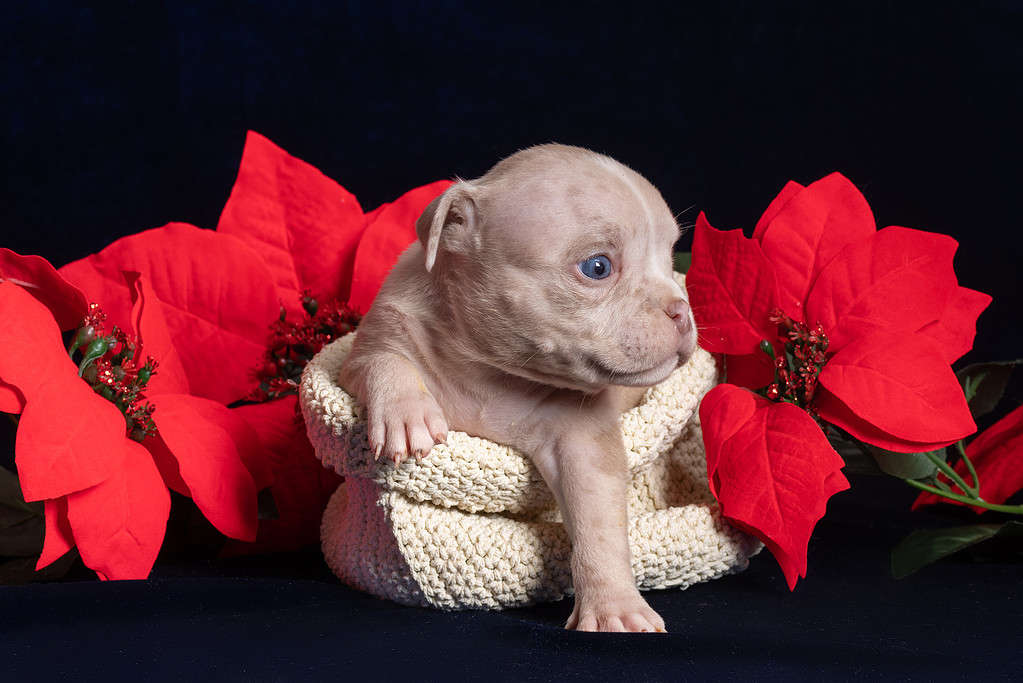
Use commercial pet-off spray to keep cats and dogs out of Christmas poinsettias.
©Alena Ivochkina/iStock via Getty Images
If essential oils and chopping up citrus fruit isn’t your thing, buy a pet deterrent spray and give your poinsettia soil and foliage a good coating.
It’ll need replenishment, but if it works, it’s a low-hassle way to protect your poinsettia.
8. Strategic Aluminum Foil
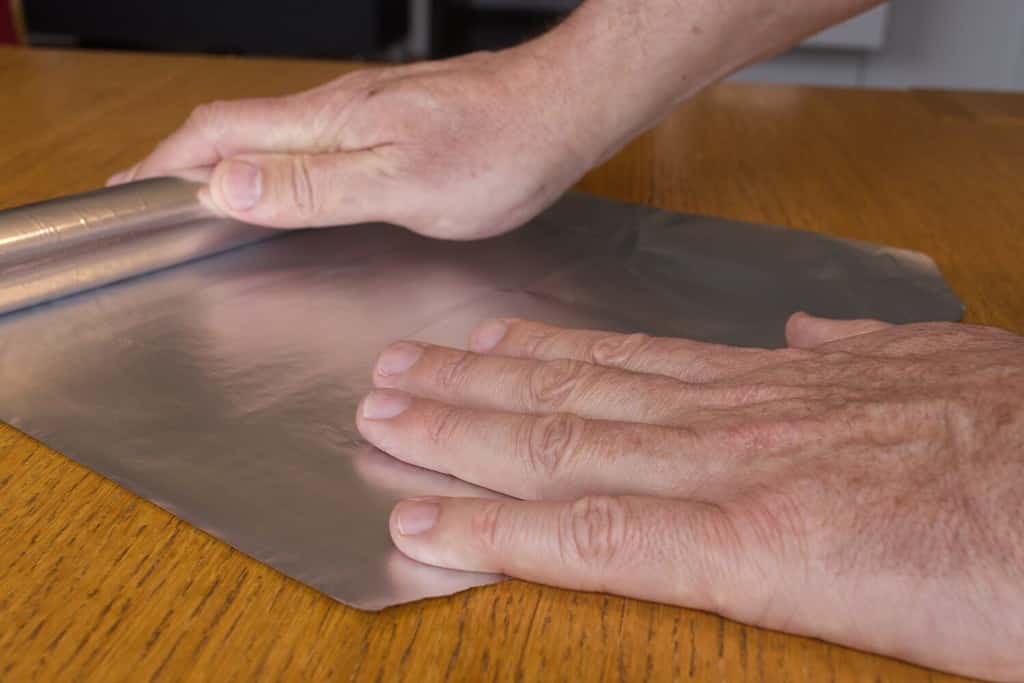
Many cats and dogs dislike the texture and sound of aluminum foil.
©Below the Sky/Shutterstock.com
Cats dislike aluminum foil’s texture on their paws and its hissy scrunching noises.
Try covering the soil with aluminum foil or placing the poinsettia container on. The noise might deter Kitty from spraying on the foliage, chewing it, or simply pushing it off the table. It looks pretty festive too.
Aluminum foil is also a great way to deter spraying in the house. When urine hits the foil, it makes a hissing sound that frightens many cats.
9. Stealthy Distraction Techniques

Distract poinsettia-bound pets with new toys and lots of attention.
©Evrymmnt/iStock via Getty Images
Perhaps that poinsettia is such an object of interest because it’s new. Pets love investigating new home items’ interesting smells, tastes, and textures.
Distraction is key! Try purchasing your cat or dog a new toy, such as a puzzle feeder smeared with pet-safe food or a new catnip mouse, to distract your pets from the poinsettia.
Failing that, screw up pieces of paper for a cat chase, or throw your dog an existing toy. Mental stimulation prevents boredom and might even save your Christmas plants.
10. Buy An Air Spray
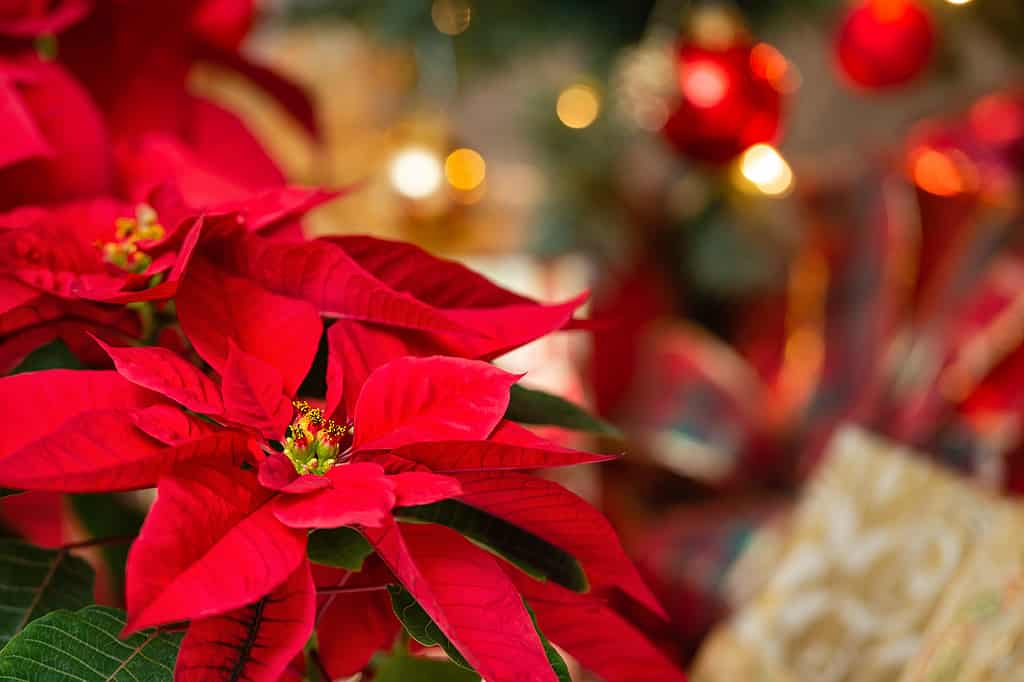
Buy a harmless air spray to keep cats and dogs at a distance.
©leekris/iStock via Getty Images
Try purchasing an air spray to train your cat and dog. These motion-activated sprayers give a harmless puff of air when Rover or Tiddles gets too close. The noise is often enough to put them off their destructive business and keep them away for good.
After Christmas, you could use it to keep pets off the kitchen counters.
11. Get A Plant Just For Them
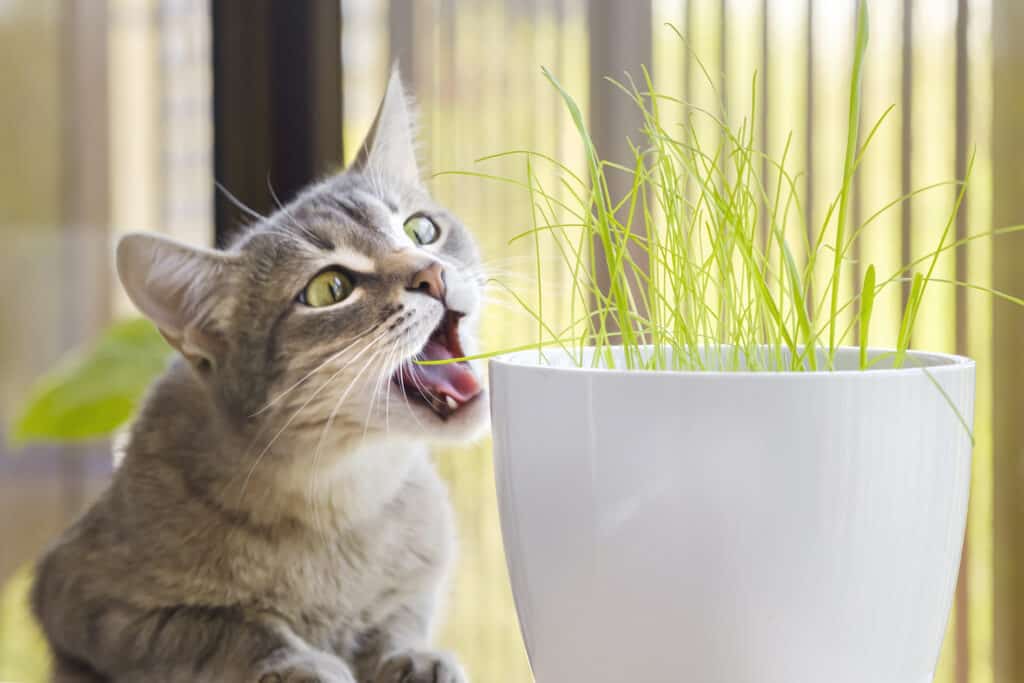
Cat grass is a good distraction from toxic poinsettias.
©iStock.com/Kseniia Soloveva
If your cat just won’t stop harassing the poinsettia, purchasing Kitty her plant to destroy is wise.
Cat grass is a good choice. Inexpensive seeds grow within a week or buy fully-grown cat grass online. With something better to chew on, Mr Bigglesworth may ignore the Christmas poinsettia.
12. If All Else Fails, Go Artificial
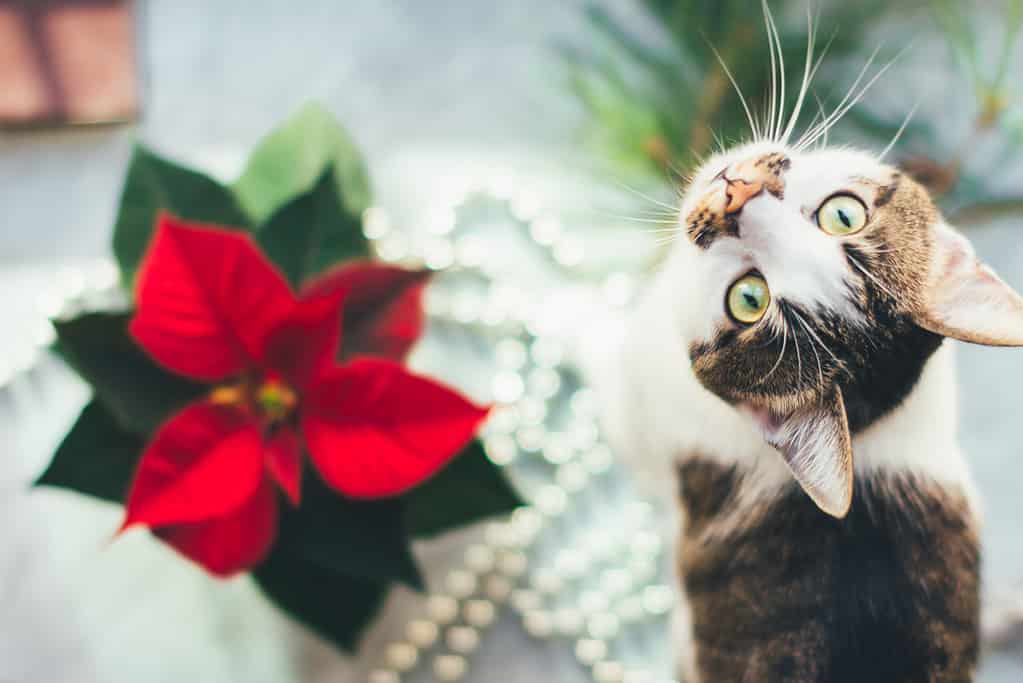
If your pet won’t leave your poinsettia alone, go artificial.
©Anna_Hirna/iStock via Getty Images
Long gone are the days of trashy-looking plastic plants. Good quality modern faux plants are incredibly detailed. It’s hard to tell the difference sometimes.
Fake plants are a great option for greenery, but the spot is near a hot radiator, a chilly hallway, or there’s barely any natural light to keep it alive.
Faux poinsettias bring plenty of Christmas magic, and your cat or dog won’t be interested.
The photo featured at the top of this post is © Anna_Hirna/iStock via Getty Images
Thank you for reading! Have some feedback for us? Contact the AZ Animals editorial team.







